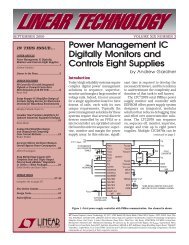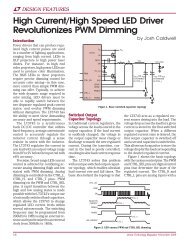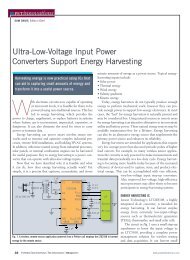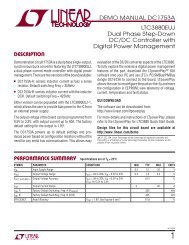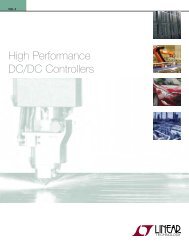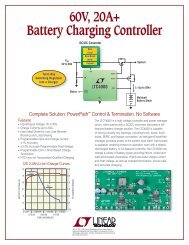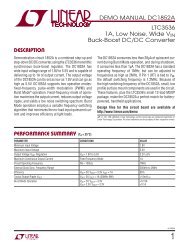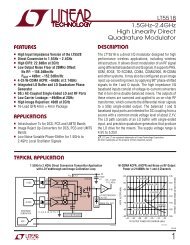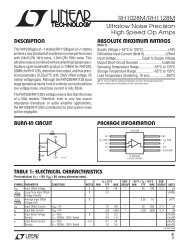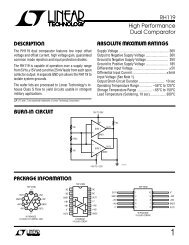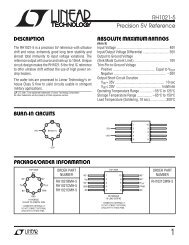LTC6945 - Ultralow Noise and Spurious 0.35GHz to 6GHz Integer-N ...
LTC6945 - Ultralow Noise and Spurious 0.35GHz to 6GHz Integer-N ...
LTC6945 - Ultralow Noise and Spurious 0.35GHz to 6GHz Integer-N ...
You also want an ePaper? Increase the reach of your titles
YUMPU automatically turns print PDFs into web optimized ePapers that Google loves.
APPLICATIONS INFORMATION<br />
Choosing the correct COUNTS depends upon the ratio of<br />
the b<strong>and</strong>width of the loop <strong>to</strong> the PFD frequency (BW/fPFD).<br />
Smaller ratios dictate larger COUNTS values. A COUNTS<br />
value of 128 will work for the ratio of 1/25. From Table 4,<br />
LKCT[1:0] = 1 for 128 counts.<br />
Using Table 5 with the previously selected ICP of 11.2mA,<br />
gives CP[3:0] = 11. This is enough information <strong>to</strong> program<br />
Reg09:<br />
Reg09 = hDB<br />
To enable the lock indica<strong>to</strong>r, write Reg07:<br />
Reg07 = h01<br />
Charge Pump Function Programming<br />
The DC1649 includes an LT1678I op amp in the loop filter.<br />
This allows the circuit <strong>to</strong> reach the voltage range specified<br />
for the VCO’s tuning input. However, it also adds an<br />
inversion in the loop transfer function. Compensate for<br />
this inversion by setting CPINV = 1.<br />
This example does not use the additional voltage clamp<br />
features <strong>to</strong> allow fault condition moni<strong>to</strong>ring. The loop<br />
feedback provided by the op amp will force the charge<br />
pump output <strong>to</strong> be equal <strong>to</strong> the op amp positive input<br />
pin’s voltage. Disable the charge pump voltage clamps by<br />
setting CPCHI = 0 <strong>and</strong> CPCLO = 0. Disable all the other<br />
charge pump functions (CPMID, CPRST, CPUP <strong>and</strong> CPDN)<br />
<strong>to</strong> allow the loop <strong>to</strong> lock:<br />
Reg0A = h10<br />
The loop should now lock. Now unmute the output by<br />
setting OMUTE = 0 (assumes the MUTE pin is high):<br />
Reg02 = h08<br />
REFERENCE SOURCE CONSIDERATIONS<br />
A high quality signal must be applied <strong>to</strong> the REF ± inputs as<br />
they provide the frequency reference <strong>to</strong> the entire PLL. As<br />
mentioned previously, <strong>to</strong> achieve the part’s in-b<strong>and</strong> phase<br />
noise performance, apply a CW signal of at least 6dBm<br />
<strong>LTC6945</strong><br />
in<strong>to</strong> 50Ω, or a square wave of at least 0.5VP-P with slew<br />
rate of at least 40V/μs.<br />
The <strong>LTC6945</strong> may be driven single-ended <strong>to</strong> CMOS levels<br />
(greater than 2.7VP-P). Apply the reference signal directly<br />
without a DC-blocking capaci<strong>to</strong>r at REF + , <strong>and</strong> bypass REF –<br />
<strong>to</strong> GND with a 47pF capaci<strong>to</strong>r. The BST bit must also be<br />
set <strong>to</strong> “0”, according <strong>to</strong> guidelines given in Table 2.<br />
The <strong>LTC6945</strong> achieves an in-b<strong>and</strong> normalized phase noise<br />
floor of –226dBc/Hz (typical). To calculate its equivalent<br />
input phase noise floor LM(IN), use Equation 10:<br />
LM(IN) = –226 + 10 • log10(fREF) (10)<br />
For example, using a 10MHz reference frequency gives<br />
an input phase noise floor of –156dBc/Hz. The reference<br />
frequency source’s phase noise must be approximately<br />
3dB better than this <strong>to</strong> prevent limiting the overall system<br />
performance.<br />
IN-BAND OUTPUT PHASE NOISE<br />
The in-b<strong>and</strong> phase noise produced at fRF may be calculated<br />
by using Equation 11.<br />
( )<br />
L M(OUT) = –226+10 log 10 f PFD<br />
or<br />
⎛<br />
+20 log10 ⎝<br />
⎜<br />
f RF<br />
f PFD<br />
⎞<br />
⎠<br />
⎟<br />
LM(OUT) = –226+10 log10 ( fPFD) ⎛ N⎞<br />
+20 log10 ⎝<br />
⎜<br />
O⎠<br />
⎟<br />
(11)<br />
As seen for a given PFD frequency f PFD, the output in-b<strong>and</strong><br />
phase noise increases at a 20dB-per-decade rate with the<br />
N divider count. So, for a given output frequency fRF, f PFD<br />
should be as large as possible (or N should be as small as<br />
possible) while still satisfying the application’s frequency<br />
step size requirements.<br />
6945f<br />
21



